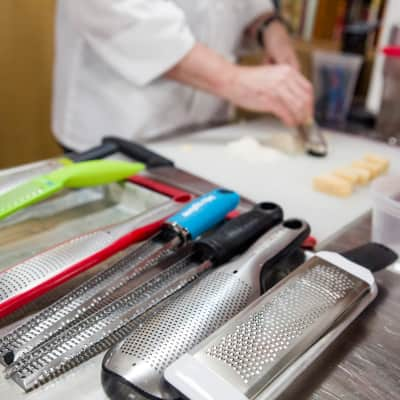Zesting citrus kinda stresses me out.
Why You Should Zest Your Citrus Upside-Down
Published Oct. 20, 2022.

Apart from the many nearly-shredded fingers I often end up with during the process, I always feel like there’s some way I could be doing the whole thing… better.
Whether I'm zesting limes for Key Lime Pie, or lemons for a Classic Lemon Tart (or just getting in the habit of zesting and freezing all citrus before I cut into it) I often end up with citrus covered in patchy zested spots.
It feels like I never use the full potential of their surface area.
That’s why my world opened up—the clouds parted and the angels sang in chorus—when I heard about a new method. It’s a simple maneuver that you may be approximating in your own zesting adventures, but you’ve got to do it right to see the benefits.
Sign up for the Notes from the Test Kitchen newsletter
Our favorite tips and recipes, enjoyed by 2 million+ subscribers!
We always like to use rasp-style graters for our citrus zesting needs, and have thoroughly tested a bunch of them for the best results. And while equipping yourself with the best tools for the job will help, the method you use will make all the difference.
Follow the steps below to put it into action.
The Best Way to Zest
Zesting your citrus upside down gives you the ultimate control over the amount of zest you're collecting.
- Hold your fruit above a bowl and position your rasp-style grater on top.
- Rather than rubbing the fruit on the underside of the grater, instead keep it stationary and glide the grater across the fruit, allowing the zest to pile up on top of the sharp rasps.
The Best Rasp-Style Graters
Want the best grater? Look for the stamp of approval.Executive editor for ATK Reviews Hannah Crowley swears by this method, and first heard about this method from colleague Lan Lam, who picked it up from a sous chef in her restaurant days. (Want to learn even more from Lan? Check out her YouTube series Techniquely with Lan Lam for many helpful cooking techniques.)
When Hannah was testing rasp-style graters, she used this method regularly. It was (and is!) a game-changer.
“When you are moving the fruit and not the zester, the part you are zesting is face down, so you can't see it,” Hannah says. “When you are moving the zester and not the fruit, you can see where you are going on the lemon so you can move around it more quickly and efficiently.”
“That way, you can better track your progress and get all of the zest,” she adds.
